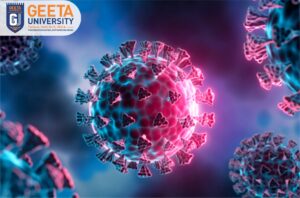Smart Farming Trends in India
UncategorizedSmart Farming Trends in India
- June 27, 2024
- Geeta University
1. Adoption of Precision Agriculture:
Precision agriculture is a farming management concept that utilizes technology to observe, measure, and respond to inter- and intra-field variability in crops. The adoption of precision agriculture techniques in India is gaining momentum, driven by the need to enhance productivity, optimize resource use, and ensure sustainability.
GPS and GIS Technologies: Farmers are increasingly using GPS and GIS technologies for soil mapping, field mapping, and crop monitoring. These technologies help in precise application of inputs, leading to better crop yields and reduced wastage.
Remote Sensing: Satellite imagery and drone-based remote sensing are being used to monitor crop health, detect diseases, and assess crop growth stages.
The adoption of precision agriculture in India represents a significant advancement towards modernizing the agricultural sector. By leveraging technology, data analytics, and automated systems, precision agriculture enhances productivity, reduces costs, and promotes sustainable farming practices. Overcoming the challenges through education, financial support, and infrastructure development will be key to widespread adoption. As more farmers embrace precision agriculture, the overall resilience and efficiency of Indian agriculture will improve, contributing to food security and economic growth.

Admission Open 2024-2025
For Your bright Future
2. Internet of Things (IoT) in Agriculture:
The Internet of Things (IoT) is revolutionizing agriculture by integrating advanced technologies to improve efficiency, productivity, and sustainability. Here are some key aspects and applications of IoT in agriculture:
a) Precision Farming
i. Soil Monitoring: IoT sensors monitor soil moisture, temperature, and nutrient levels in real-time, allowing farmers to optimize irrigation and fertilization. This helps in conserving water and reducing chemical use.
ii. Weather Monitoring: IoT devices provide accurate and localized weather data, helping farmers plan their activities around weather conditions and reduce the risk of crop damage.
b) Automated Irrigation Systems
i. Smart Irrigation Controllers: These systems use real-time data from soil moisture sensors and weather forecasts to adjust the watering schedules automatically, ensuring optimal water usage and preventing over-irrigation.
c) Crop Management
Crop Health Monitoring: IoT sensors and drones equipped with multispectral and hyperspectral cameras monitor crop health, detect diseases, and assess nutrient deficiencies. This enables early intervention and reduces crop loss.
Pest and Disease Management: IoT devices can detect the presence of pests and diseases through various indicators (e.g., temperature, humidity), allowing for timely and targeted pest control measures.
d) Livestock Monitoring
Animal Tracking: IoT-enabled collars and tags track the location, health, and activity of livestock. Farmers can monitor feeding patterns, detect illnesses early, and ensure the well-being of their animals.
Environmental Monitoring: Sensors monitor environmental conditions such as temperature and humidity in livestock housing, ensuring optimal living conditions and preventing stress or disease outbreaks.
e) Supply Chain Management
Traceability: IoT devices can track the movement of produce from farm to table, ensuring transparency and traceability in the supply chain. This helps in maintaining quality and building consumer trust.
Cold Chain Monitoring: IoT sensors monitor temperature and humidity in storage and transportation, ensuring perishable goods are kept in optimal conditions to reduce spoilage and maintain quality.
f) Greenhouse Automation
Climate Control: IoT systems monitor and control environmental parameters in greenhouses, such as temperature, humidity, and CO2 levels, ensuring optimal growing conditions for crops.
Automated Systems: IoT-enabled systems automate tasks like watering, shading, and ventilation, reducing labor and increasing efficiency.
g) Data Analytics and Decision Support
Big Data Analytics: IoT devices generate vast amounts of data that, when analyzed, provide valuable insights into crop performance, soil health, and environmental conditions. This helps farmers make informed decisions and optimize their practices.
Decision Support Systems: IoT-integrated platforms provide farmers with recommendations on planting schedules, irrigation, fertilization, and pest control, improving overall farm management.
h) Resource Management
Water Management: IoT sensors help in monitoring water usage and detecting leaks in irrigation systems, ensuring efficient use of water resources.
Energy Management: IoT devices monitor energy consumption in farm operations and optimize the use of renewable energy sources, reducing costs and environmental impact.
i) Farm Management Systems
Integrated Platforms: IoT-enabled farm management systems integrate data from various sensors and devices, providing a comprehensive view of farm operations. These platforms help in planning, monitoring, and managing all aspects of farming activities.
Mobile Applications: Farmers can access real-time data and insights through mobile apps, allowing them to monitor and manage their farms remotely.
3. Data Analytics and Artificial Intelligence (AI):
Data Analytics and Artificial Intelligence (AI) are transforming agriculture by enabling more precise, efficient, and sustainable farming practices. These technologies provide actionable insights and automate decision-making processes, helping farmers to optimize their operations.
Predictive Analytics: Use of AI and machine learning algorithms to analyze historical data and predict crop yields, pest outbreaks, and weather patterns. This helps farmers in planning and risk management.
Decision Support Systems: Development of AI-based decision support systems that provide farmers with recommendations on crop selection, planting schedules, and input management.
Data Analytics and AI are pivotal in advancing modern agriculture by providing deeper insights, enhancing decision-making, and automating processes. These technologies help farmers increase productivity, reduce costs, and promote sustainable practices, ultimately contributing to food security and environmental conservation. The integration of Data Analytics and AI in agriculture represents a significant step towards a more efficient and resilient agricultural sector.
4. Digital Platforms and Mobile Apps:
Digital platforms and mobile apps are transforming agriculture by providing farmers with access to information, resources, and tools that enhance productivity, efficiency, and sustainability. These technologies bridge the gap between traditional farming practices and modern digital advancements.
Farm Management Software: Digital platforms that offer comprehensive farm management solutions, including crop planning, resource management, and financial tracking.
Mobile Applications: A surge in mobile apps providing farmers with access to market prices, weather updates, agricultural advisories, and e-commerce platforms to buy inputs and sell produce.
Digital platforms and mobile apps are revolutionizing agriculture by empowering farmers with technology and information. These tools enhance farm productivity, improve market access, optimize resource use, and promote sustainable practices. As technology continues to evolve, the role of digital solutions in agriculture will only grow, contributing to a more efficient, profitable, and sustainable agricultural sector.
5. Automation and Robotics:
Drones: Use of drones for various
applications such as aerial spraying, crop monitoring, and field surveillance.
Drones offer high precision and efficiency, especially in large farms. Drones,
also known as Unmanned Aerial Vehicles (UAVs), are increasingly being utilized
in agriculture to enhance productivity, efficiency, and sustainability. They
provide farmers with a bird’s-eye view of their fields, allowing for precise
monitoring and management.
Benefits of Using Drones in Agriculture:
üCost-Effective:
Drones reduce the need for manual labor and lower input costs by ensuring
precise application of resources.
ü
Time-Saving:
Drones cover large areas quickly, providing real-time data that speeds up
decision-making processes.
ü
Improved
Accuracy: High-resolution images and advanced sensors offer precise data,
enhancing the accuracy of agricultural practices.
ü
Sustainability:
Drones promote sustainable farming by optimizing resource use, reducing
chemical runoff, and minimizing environmental impact.
ü
Enhanced
Productivity: By providing timely and accurate information, drones help in
improving crop health and yield, contributing to higher productivity.
ü
Robotic
Machinery: Introduction of robotic harvesters, weeders, and planters that
reduce labor dependency and increase operational efficiency.
Challenges
and Considerations:
Ø
Regulatory
Compliance: Farmers need to comply with aviation regulations and obtain
necessary permissions to operate drones.
Ø
Initial
Investment: The cost of purchasing and maintaining drones can be high, though
it is often offset by long-term savings and benefits.
Ø
Technical
Expertise: Farmers need to acquire the technical skills to operate drones and
interpret the data they provide.
The use of
drones in agriculture represents a significant technological advancement,
offering numerous benefits that enhance farm management, increase efficiency,
and promote sustainability. As drone technology continues to evolve and become
more accessible, its adoption in agriculture is expected to grow, further
transforming the agricultural landscape. Use of drones for various applications such as aerial spraying, crop monitoring, and field surveillance. Drones offer high precision and efficiency, especially in large farms. Drones, also known as Unmanned Aerial Vehicles (UAVs), are increasingly being utilized in agriculture to enhance productivity, efficiency, and sustainability. They provide farmers with a bird’s-eye view of their fields, allowing for precise monitoring and management.
Benefits of Using Drones in Agriculture:
Cost-Effective: Drones reduce the need for manual labor and lower input costs by ensuring precise application of resources.
Time-Saving: Drones cover large areas quickly, providing real-time data that speeds up decision-making processes.
Improved Accuracy: High-resolution images and advanced sensors offer precise data, enhancing the accuracy of agricultural practices.
Sustainability: Drones promote sustainable farming by optimizing resource use, reducing chemical runoff, and minimizing environmental impact.
Enhanced Productivity: By providing timely and accurate information, drones help in improving crop health and yield, contributing to higher productivity.
Robotic Machinery: Introduction of robotic harvesters, weeders, and planters that reduce labor dependency and increase operational efficiency.
Challenges and Considerations:
Regulatory Compliance: Farmers need to comply with aviation regulations and obtain necessary permissions to operate drones.
Initial Investment: The cost of purchasing and maintaining drones can be high, though it is often offset by long-term savings and benefits.
Technical Expertise: Farmers need to acquire the technical skills to operate drones and interpret the data they provide.
The use of drones in agriculture represents a significant technological advancement, offering numerous benefits that enhance farm management, increase efficiency, and promote sustainability. As drone technology continues to evolve and become more accessible, its adoption in agriculture is expected to grow, further transforming the agricultural landscape.
6. Climate-smart Agriculture:
Climate Smart Agriculture (CSA) is an approach to farming that aims to increase agricultural productivity and resilience to climate change while reducing greenhouse gas emissions. It involves the integration of various strategies, practices, and technologies to make agriculture more sustainable and climate-resilient
Climate-resilient Crops: Research and development of crop varieties that are resilient to climate change, drought, and other environmental stresses.
Sustainable Practices: Promotion of sustainable farming practices such as organic farming, conservation agriculture, and integrated pest management to mitigate the impact of climate change.
Climate Smart Agriculture is essential for ensuring food security, sustainable development, and resilience in the face of climate change. By integrating a variety of practices and technologies, CSA helps farmers adapt to changing climate conditions, mitigate their environmental impact, and maintain or improve agricultural productivity. The success of CSA depends on multi-stakeholder collaboration, supportive policies, and continuous innovation and research.
Conclusion
If you are a good listener and can provide solutions for people’s problems, a life coach is the perfect business idea for you. You can do this face to face, through a podcast, on YouTube or other video streaming platforms, etc.
We have shortlisted trendy business ideas for fresh MBA graduates. These ideas suit the respective best MBA courses. Most of these ideas do not require huge investment and ensure quicker ROI on the business. Start today your journey of entrepreneurship with one of these business ideas.
Tags
Related Posts

Education trends after Covid 19 – Geeta University
The COVID 19 pandemic flipped the world’s education system upside down this year, causing a significant shift in how pupils learn and teachers teach. Education Trends after Covid 19 The COVID 19 pandemic flipped the world’s education system upside down

The future of Cryptocurrency in India – Geeta University
Gartner, leading research and consulting company, had predicted that the banking industry would receive $ 1 billion in business value in the use of blockchain Crypto currencies by 2022. The Future of Cryptocurrency in India Gartner, leading research and consulting

To be a Civil Engineer one must know – Geeta University
Civil engineering is in high demand for work. Working in this field requires very clear skills. It is not easy to find a great civil engineer and the best are richly rewarded. To Be a Civil Engineer one must know
